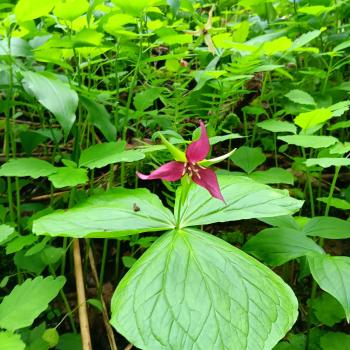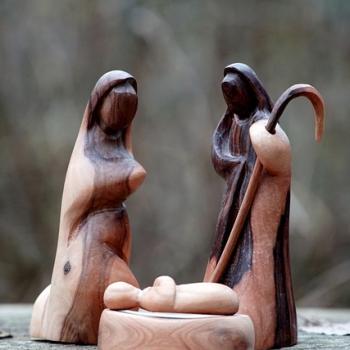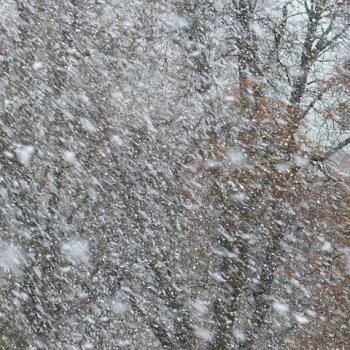On Tuesday night, we met at her house. Her parents owned a bakery and she’d baked cakes many times before. The secret, she said, was that bakeries used cake mix, but they mixed a pinch of this and a bit of that into the mix to make it taste homemade. I watched her carefully as she filled out the boxed mix with flour and baking powder. I helped stir the batter. While the cakes were baking, my friend’s housemate, an older graduate student with a pierced nose, came in to read to us. She’d composed an essay for class about her conversion to Catholicism, and she wanted our opinion on the writing style.
In the essay, she told the story of the time she’d gone to Confession in Europe shortly after her conversion. The priest was a gruff old Italian Franciscan with gloved hands; he seemed very good at guessing what she was going to say before she said it, as if he could read her soul. The night after she went to confession, she happened to see a photograph of Saint Pio just before his death. It looked exactly like the priest to whom she’d just gone to confession. She was sure Saint Pio had appeared from Heaven, to forgive her sins.
I couldn’t doubt the story– you couldn’t either, if you’d seen Christ transfigured in her face as she read it.
I said I wished that Saint Pio would appear to me.
“I think he only appears to people who are in big trouble,” said the graduate student, putting away her essay.
I privately recollected that I was in big trouble, myself, but I didn’t like to say so to a stranger– not even a stranger who had just read me her life story.
We frosted the cake and covered it with coconut until it looked like a giant snowball. Then the graduate student got out a two-foot carved and painted wooden statue of Saint Pio and a three-inch white porcelain statue of the Virgin Mary, and lit a candle.
“It’s not appropriate to have Mary so much smaller, but if you get down on the floor like this,” she explained, kneeling very low, “They look the same size.”
I thought it was perfectly appropriate that a Lady so profoundly humble would look so small, even compared to a Friar Minor. It was perfect symbolism, that we had to be almost prostrate on the ground, to see Our Lady the same size as any other human being. Perfect to have pure unstained white glass standing at the foot of wood. A thousand manifestations of Christ were transfigured in the roommate’s devotional statues. We prayed the Rosary there before the Virgin Mary and Saint Pio. I prayed that he’d appear to me, because I was in big trouble.
I explained my big trouble in the car on the way home. I explained that I wasn’t going home over Thanksgiving break, because I was trying to cut ties with my family and the culture surrounding my family. We were in a conflict I couldn’t see my way to resolving without taking even more emotional abuse. My friend was shocked, but almost relieved. She confided in me that she’d actually just been in such a situation. Her fiance had abused her until she was nearly suicidal; she’d broken off the relationship, and fled to Ohio to finish her education. She had to take medication for panic now.
Sitting in the dark car, watching her young, girlish face as she described her suffering, I saw Christ transfigured before me.
The next day, at the soup kitchen, after beans and sliced bread, we presented Lorenzo with the beautiful, pure white and fluffy coconut cake. All the guests at the soup kitchen sang Happy Birthday to him. He was thrilled, happier than I’d ever seen anyone at the dismal little soup kitchen. You’d have thought we’d handed him a ticket out of poverty instead of a cake– and, if it’s true that loneliness is the worst form of poverty, maybe we had.
“Ain’t nothin’ gonna spoil my day today,” said Lorenzo, Christ transfigured in pure joy on his face. “If someone insults me, I’m just gonna smile.”
That was one of the last soup kitchen days of the Fall semester. I didn’t see Lorenzo or Pastor Tony again after that. My friend went to Texas to be with her family for Thanksgiving, and never came back to the University; her trauma, she said, was too much for her to be so far from them. It took me over a year to fully cut ties with the community I grew up in, but I did stay alone in my apartment over Thanksgiving, praying to Saint Pio for company.
I didn’t see the graduate student who had confessed to Saint Pio again for years. But one day, we saw one another at daily Mass. We greeted one another like old friends.
We’d been up on the mountain together and seen the Transfiguration; then we’d gone down into the desert, as everyone must. But we’d seen the Transfiguration, and that made us sisters.













